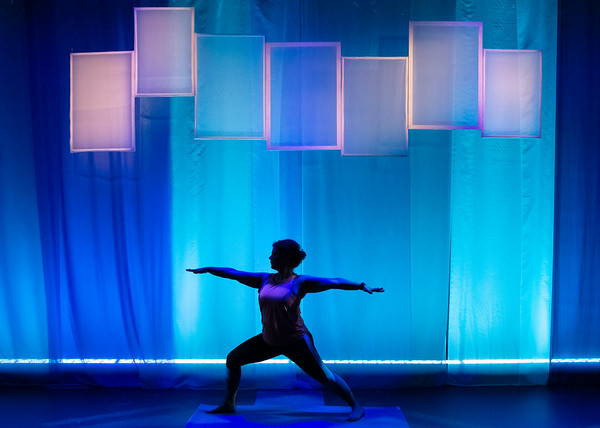What If They Ate The Baby?
15 Vandam St., Manhattan, NYC
November 19-December 22, 2025
 |
| Xhloe Rice and Natasha Roland. Photo by Molly White. |
Serial Edinburgh Fringe Festival First Award winners and current SoHo Playhouse artists in residence Xhloe and Natasha, having won last winter's SoHo Playhouse International Fringe Encore Theater Series Overall Excellence Award for
A Letter to Lyndon B. Johnson or God: Whoever Reads This First (read our review
here), return to the SoHo's stage as the year draws to a close with
What If They Ate The Baby? First performed at Edinburgh Fringe in 2023,
What If They Ate The Baby? puts on full display the exhilarating fusion of clowning, physical theater, and the absurd for which the multidisciplinary duo is known. Experimenting with form and absurdism in ways that recall playwrights such Edward Albee and Caryl Churchill, this exceptional production flawlessly mingles humor with unease in a dystopian dive into gender, desire, and hegemony via the figure of the American housewife.
We first meet Shirley (Natasha Roland), who, in a dress, heels, and rubber kitchen gloves all the same shade of bright yellow, scrubs the floor on her hands and knees, pausing only intermittently in reaction to a thumping like footsteps on an upper floor. A surreal transition brings us to Dottie (Xhloe Rice), come to return a baking dish and dressed as a pink reflection of Shirley (although her gloves are not rubber), including the green stains and handprints that mar the pair's 1950s-style clothing. As they converse, the two mirror each other in their performative mannerisms and the chirpy artificiality of their speech as well. At this early stage, their movements possess an almost animatronic quality at times, which puts one in mind of scholar Judith Butler's theorization of gender as a type of impersonation constructed through the continuous repetition of performative acts. At the same time, Shirley and Dottie's periodic mirroring of even one another's small movements or gestures can suggest an unspoken bond or synchronicity.
 |
| Natasha Roland and Xhloe Rice. Photo by Morgan Mcdowell. |
The women's pleasantries–asking after each other's menfolk and recipes, Shirley's inviting Dottie to have some casserole, and so on–are consistently underlain with a current of anxiety. Shirley, for example, claims that her husband isn't at home but also tells Dottie not to be too loud, and Dottie offers to lend Shirley a cookbook that she says is "worth the read" in such a way that makes it seem like a coded offer of something forbidden. The women also make references to "everything going on," and, more explicitly, discuss a female neighbor having been taken away for questioning; her possession of modern art is enough to make her suspicious in Dottie and Shirley's accounting, but, in another of many disjunctions between the surface and what it conceals, both women admit to having been in this neighbor's house. As the play progresses, we see a number of these moments repeated, with changes in the actors' delivery and other divergences from previous iterations altering and layering meaning. The overall impression of these repetitions is a facade becoming more ragged, and between them, interludes, often featuring dance, present impressions, perhaps imaginings, of what simmers behind that facade.
 |
| Natasha Roland and Xhloe Rice. Photo by Molly White. |
Part of that is fear. Surveillance and control by the state and by the patriarchy overlap, and the women's reactions to the sounds from upstairs and knocks at the door, as well as their inability to speak directly (except maybe, it is implied in some of the dance sequences, when the music is so loud that we can't hear them), express their anxiety over such monitoring. The many window frames that adorn the walls of the set give the impression of Shirley and Dottie being watched as much as they do of allowing the women to see out (all those windows, and they still never know who's at the door). Appearance, of course, as a gender act in Butler's sense, is also subject to surveillance: the characters' use of the (odd when you think about it) phrase "putting my face on" links the clown's red circles in the performers' makeup to women's makeup more broadly and to Dottie's putting on the literal (second) face of a clear plastic mask at multiple points. Violence forms another undercurrent, from references to how angry one of the husbands gets and a dream of bodily disintegration to fantasies (probably) of violence towards the self and others (Dottie directly invokes an Edgar Allan Poe story at one point), including
Bones and All-style consumption. This last is also a strong expression of desire; and each woman's moments of resistance and inertia regarding their desires speaks to the mutual reinforcement enacted by repression and oppression. The thematically significant music cues, from 50s pop to contemporary hip hop and industrial, and lighting design that contrasts more naturalistic stretches with color and strobing, help to navigate the surreal shifts of the looping narrative and work in superb tandem with the impressive physical precision, impeccable comedic timing, and evocative deconstructions of Xhloe and Natasha's performances.
What If They Ate The Baby? unleashes the energies that its characters can't, and the result is a true theatrical feast.
-John R. Ziegler and Leah Richards






Comments
Post a Comment